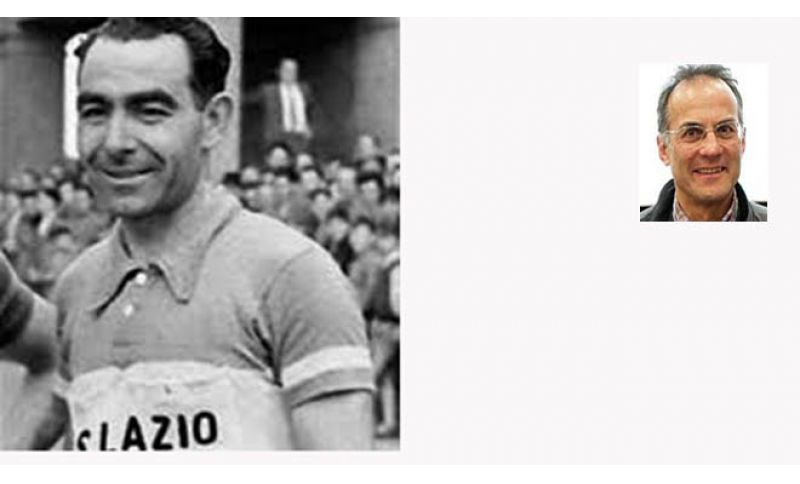

Gran Premio Burro Gigli of 1957, also known as the Roma-Velletri, a semi-classic for amateurs. Attacks and counterattacks, with the selection happening on the Rocca di Papa climb. Three riders remained at the front: Arnaldo Pambianco and the two Trapè brothers, Ardelio and Livio. Pambianco, nicknamed Gabanìn, wearing the white jacket of a butcher's apprentice from Bertinoro, was wearing the blue jersey of the Italian national team, and that year would become Italian champion, and four years later would win the Giro d'Italia ahead of Jacques Anquetil; Ardelio was 38 years old and Livio was turning 20 that day - May 26th - both wearing the yellow and red wool jersey of Roma.
The two Trapè alternated at the front, with Pambianco passively sitting on their wheel. Until, exasperated, Ardelio addressed Giovanni Proietti, the Italian team coach: "Commander, what a disgrace, an old man and a young boy with a blue jersey sitting on our wheel". Proietti leaned out of the team car and pointed at Pambianco: "Can't you see, he has a flat tire". Standing right in front of him, neither Ardelio nor Livio had noticed. Ah yes, Ardelio thought to himself, let's take advantage of this. And with an attack, the two Trapè got rid of their uncomfortable breakaway companion. In the sprint, there was no contest: no mercy for the old Ardelio, with youth prevailing in the form of Livio (and perhaps also Ardelio's generosity).
Ardelio Trapè was the grand old man of the "pure" riders. His admirers called him "the Gino Bartali of amateurs", his friends simply Lello. An Etruscan from Montefiascone, he was the firstborn of Tarquinio, a bus driver - with license number 16 in his town - on the Rome-Montefiascone-Rome route along the Cassia road. The other children were two boys and three girls, in order of appearance: Elia (accent on the e), Quinto, Maria, Anna, and Livio. Ardelio started racing in 1938, at 19 years old, competing and winning against riders of the caliber of Mario Ricci and Alfredo Martini. He was a true revelation: in his first year, he collected eight victories, including the Eleven Provinces Championship, and nine second places. "If I had trained well - he would sigh - I would have won them all. Instead, I went to races with leg pain".
The Lazio team should have registered him with the Athletes Company, promised but procrastinated, and when war was declared, Ardelio was called to arms and sent to Africa, to Libya, assigned to checking and restoring telephone lines, thus on the front line, and it seems he participated in (and saved his skin during) the Battle of Tobruk. One day, Ardelio would recount, "Benito Mussolini himself arrived, climbed onto a platform and began to harangue. From the crowd, a shout rose: 'We're fed up!'. A chill fell. Mussolini, surprised and irritated by this protest, thundered: 'Who was that?'. 'Me', a soldier replied. 'Come here', the Duce ordered. The soldier went, and repeated 'We're fed up', explaining that they had been there for two and a half years, without leave, without the possibility of seeing wives, children, and parents. Mussolini ordered them all to be sent home, including me". The soldiers who came to replace them would die in the Battle of El Alamein.
It wasn't easy for him either, Ardelio. Another year, away from home, first in Ischia, then in Irpinia, welcomed by a family, treated like one of their own, eating, sleeping, and working, then finally home, where he found everything to be rebuilt. Far from being a cyclist, Ardelio rolled up his sleeves and went back to work as a cobbler. Until things somewhat settled for his family and his passion for cycling reignited. And in 1949, at 30 years old, he started racing again. It was "Zi' Peppe", Giuseppe Caprio, an old cyclist, expert mechanic, and courageous frame builder from Montefiascone, his mentor, who convinced him to restart and lent him a bike. And with that bike, Lello, without training, immediately secured a second place in Bolsena behind Leopoldo Ricci, Mario's younger brother, who would race as a professional from 1950 to 1952.
(end of the first installment - to be continued)

Se sei giá nostro utente esegui il login altrimenti registrati.